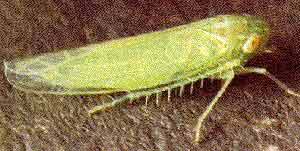Potato Leafhopper

Potato Leafhopper Control
Potato leafhoppers do not survive the winter in Kentucky. Large numbers migrate
northward from the Gulf states each spring. Females live about a month. Each can deposit 2 or 3 tiny white eggs
a day in the stems and large leaf veins of the plant. The tiny nymphs emerge from these eggs in a 7 to 10 days,
they reach the adult stage about two weeks later. The entire life cycle takes about a month, there are three or four
generations in Kentucky each year.
Damage
Leafhoppers use their sucking mouthparts to feed on plant sap.
Hopperburn, the yellow, wedge-shaped area at the tips of alfalfa leaves, is the plant's distinctive response to
leafhopper feeding. This damage is due to a toxic effect of the insect's saliva. Diseases and nutritional deficiencies
also cause yellowing of alfalfa. These symptoms usually start at the edge of the leaf but are not confined to the tips.
Intense leafhopper feeding may reduce plant height, protein and vitamin A content of the hay.
Recommendations
- WHEN TO SAMPLE: Sample each field once a week. Established alfalfa fields should be
sampled the week following the end of alfalfa weevil season. New seedings of alfalfa should be sampled beginning in mid-May.
Spring seedings of alfalfa are not cut until late June or early July and they often build up damaging leafhopper populations.
Alfalfa fields can be sampled anytime during the day as long as the foliage is not wet. Sweeping alfalfa when it is wet from
dew or rain is difficult and the samples are almost impossible to count.
- EQUIPMENT NEEDED: Yardstick or other measuring device, fifteen inch sweep net, pencil and paper, Potato Leafhopper
Economic Threshold Table.
- HOW TO SAMPLE: 1. Sweep sample at five locations in the field. Take 20 sweeps at each location. You should end up with
100 sweeps per field. 2. Count all potato leafhoppers (adults and nymphs) collected at each location and record these
numbers. 3. Randomly collect 10 stems as you walk back out of the field. Compute the average stem height, examine
each of the ten stems for buds or flowers and record this information. 4. Compute the number of leafhoppers per sweep
and use the "Potato Leafhopper Economic Threshold Table" to determine if control measures are needed.
- DETERMINING THE NEED FOR LEAFHOPPER CONTROL: Samples made just prior to the cutting of alfalfa will be useful in
determining the potential for damage in the field. If high numbers of leafhoppers (two or more/sweep) are present at that time,
spraying after cutting may be necessary to prevent economic damage. Resample the field within 7 days after cutting to
determine whether control measures are needed. After the first cutting, and for every additional cutting, use the economic
threshold table to determine when potato leafhoppers should be controlled. If your leafhopper counts exceed the critical
values on the table, control measures should be implemented. Early harvests often can be used to control potato leafhoppers.
However, insecticides may be needed especially if the alfalfa is small, usually early in the regrowth period. To protect honey
bees, do not make insecticide applications when the crop or weeds are blooming.
Potato Leafhopper Economic Threshold Table
| Average Stem Length |
# Leafhoppers/Sweep |
# Leafhoppers/ 100 Sweeps |
|
| Less than 3" |
0.2 |
20 |
| 3" to 6" |
0.5 |
50 |
| 8" to 10" |
1.0 |
100 |
| 12" to 14" |
2.0 |
200 |
- If the alfalfa is at 30% bud or more you should plan on cutting within 7 - 10 days. If this is the case, you should not spray.
However, soon after cutting you should resample the field to determine the need for control.
Harvesting will kill a high percentage of potato leafhopper nymphs and some adults. Most surviving adults will leave the field.
Because of this, stubble sprays are unnecessary. The adults will return when the regrowth is about 4" to 6" tall.
Sweep samples, beginning 5 to 7 days after harvest, will determine whether or not a treatment is necessary.
| Insecticide |
Rate per Acre |
Harvest or Graze (days) |
| |
| Baythroid 2 (cyfluthrin) |
0.8 to 1.6 fl oz |
7 |
| Dimethoate E267 |
3/4 to 1-1/2 pt |
10 |
| Furadan 4F (carbofuran) |
1 to 2 pt |
14 or 28 |
| Guthion 50WP (azinphos methyl) |
1/2 to 1 lb |
1/2 to 3/4 lb = 14, 1 lb = 16 |
| Imidan 70WP (phosmet) |
1-1/3 lb |
7 |
| Lorsban 4E (chlorpyrifos) |
1/2 to 1 pt |
1/2 pt = 7, 1 pt = 14
(Some temporary yellowing
may occur after application,
but will disappear.) |
| Malathion 57C (malathion) |
1-1/2 to 2-1/4 pts |
0 |
| Methyl Parathion 4 |
1 to 2 pts |
15 |
| Mustang Max |
2.24 to 4 fl. oz. |
3 |
| Pounce 3.2 EC (permethrin) |
4 to 8 fl oz |
more than 4 oz = 14 |
| Sevin 4F(carbaryl) |
1 qt |
7 |
| Sevin 80S (carbaryl) |
1-1/4 lbs |
7 |
| Sniper 50 PVA (azinphos methyl) |
1/2 to 1 lb |
1/2 lb = 14, 1 lb = 16 |
| Warrior 1 CS (lambda-cyhalothrin) |
1.92 to 3.2 fl oz |
forage = 1
hay = 7
Apply only to fields planted tp pure stands of alfalfa |
For more information, see Entfact 115
